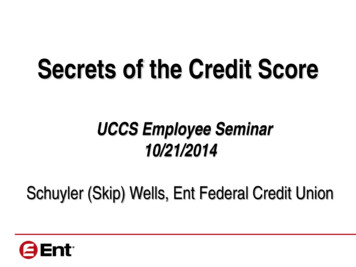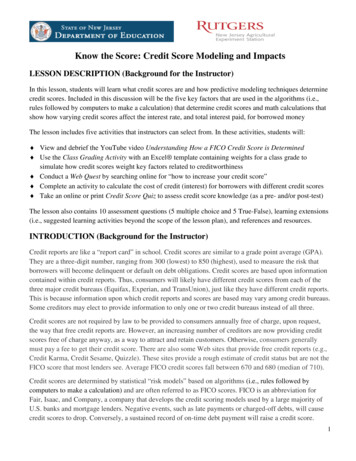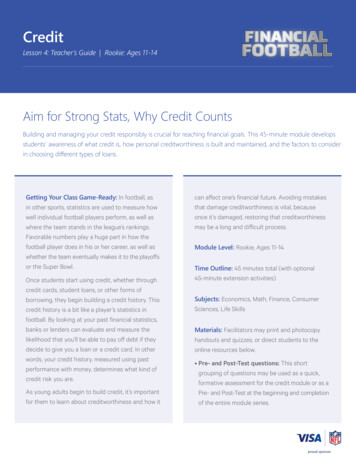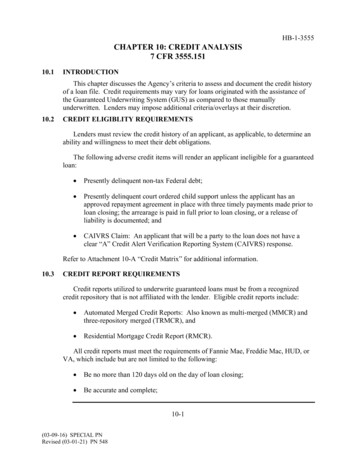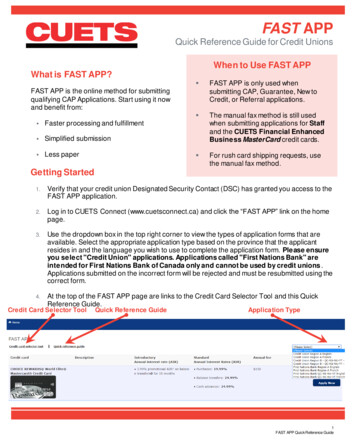
Transcription
fiold luauSarisStandardized Approach to Counterparty Credit Risk(SA-CCR)May 2019
(old ManSa ell STable of ContentsOverviewSA-CCR in the Regulatory FrameworkSupervisory Factors for CommoditiesSupervisory Factors for EquitiesImpact on Commercial End UsersAlpha Multiplier21
GolanianiSachsOverviewSA-CCR incorporates key enhancements from the Current Exposure Method (CEM) to reflect industry practices, risk management andregulatory requirements including:Netting of derivatives across multiple margin agreements under the same qualifying master netting agreement (QMNA)Full netting of long and short trades, based on certain netting criteriaDifferentiation between margined and unmargined trades in the derivative exposure calculationsHowever, there are still a number of items that need to be clarified and/or addressed to ensure appropriate implementation in the U.S. Ifimplemented in its current form, the SA-CCR NPR will result in a significant increase in capital requirements for U.S. banks, as shown below:Industry Impacts'RWA IncreaseIMM to SA-CCR122%GEM to SA-CCR30%I This deck focuses on the following topics, which we have covered in our response to the NPRNeed for comprehensive study to analyze the impact of SA-CCR on the broader regulatory capital frameworkCalibration of commodities supervisory factorsCalibration of equities supervisory factorsImpact on Commercial End Users (CEUs)Application and calibration of alphaInternational Swaps and Derivatives Association, Inc. Re: Standardized Approach to Counterparly Credit Risk ("SA-CCR19, Appendix 2.11
Old lila IliStith SSA-CCR in the Regulatory FrameworkWhen issuing the final SA-CCR rule, the U.S. Agencies (Federal Reserve Board, FDIC, and OCC) should consider the interaction of SA-CCRwith the broader regulatory framework, including the recently finalized Basel 3 Revisions and stress testing requirementsGlobal Systemically ImportantBank (G-SIB) SurchargeBCBS Final Rule: July 2018'FRB Final Rule: July 2015CountercyclIcal Capital Buffer(CCYB)BCBS Final Rule: Dec 2010tFRB Final Rule: Sept 2016SA-CCRBCBS Final Rule: Mar 2014U.S Agencies Proposal: Oct 2018Current Expected Credit Loss(CECL)U.S. Agencies Final Rule:Dec 2018Fundamental Review of theTrading Book (FRTB)BCBS Final Rule: Jan 2019U.S. Agencies Proposal: MDCredit Risk Model LimitsBCBS Final Rule: Dec 2017U.S. Agencies Proposal TADStandardized Credit Risk'BCBS Final Rule: Dec 2017U.S. Agencies Proposal TADStress Capital Buffer (SCB)BCBS Final Rule: N/AFRB Proposal Apr 2018Credit Valuation Adjustment(CVA)BCBS Final Rule: Dec 2017U.S. Agencies Proposal TADttEstimatedCapital Impact? UnknownHigher4LowerOutput FloorBCBS Final Rule: Dec 2017U.S. Agencies Proposal TADOperational RiskBCBS Final Rule: Dec 2017U.S. Agencies Proposal TBDTimeline based on expected effective date:Q3 2020: SA-CCR2022: Basel 3 Revisions (Op Risk, Credit RiskModel Limits, Credit Risk, CVA, and Output Floor)2022: FRTBRevised standards released; 2 Includes secured funding transactions (SF?) framework and equity exposures in banking bookEstimated capital impacts derived from data analyses provided by the U.S. Agencies and the Basel Committee, as well as individual bank estimates and industry data studies41
Goldman'SachsSupervisory Factors for Commoditiesl The Basel Committee appears to have calibrated the supervisory factors for commodities based on volatility in rolling spot prices. However,clients typically use derivatives to hedge their long-term business risks; therefore, most commodity derivatives have maturities of at least one yearCalibrating to spot prices significantly exaggerates the volatility of the commodities asset class, as spot prices are impacted by many factors thatdo not carry out in the forward curve, such as weather conditionsFor example, the average realized annual volatility for rolling spot NYMEX natural gas (Henry Hub) prices over the past 10 years is 47.5%.However, the average realized annual volatility over the same period is only 24.3% for the 2 year forward NYMEX natural gas contract, andonly 17.3% for the 3 year forward NYMEX natural gas contractAs illustrated on the next slide, a similar pattern is observed for other commodities: spot price volatility is consistently higher than forwardprice volatilityCalibrating to spot prices has resulted in proposed commodities supervisory factors which are significantly higher relative to historical realizedderivative market volatility than supervisory factors in other asset classes, such as interest rate products and foreign exchangeSupervisory factors for natural gas, crude oil and electricity 2y swaps are set at 1.9x-3.8x the average annual volatility from 2009-2019In contrast, factors for 5y US interest rate swaps and 5y G10 FX forwards are set at .6x-.7x average annual volatility from 2009-2019We believe that the U.S. Agencies should recalibrate the supervisory factors for commodity asset classes based on forward swap prices. Werequest that the U.S. Agencies set the supervisory factors for oil, natural gas and electricity to the recommended levels in the ISDA responseletter to the NPRIf the U.S. Agencies cannot recalibrate the commodity supervisory factors for U.S. implementation of SA-CCR, we believe they should at aminimum ensure that the supervisory factors do not exceed the Basel Committee standards1 InternationalSwaps and Derivatives Association, Inc. Re: Standardized Approach to Counteiparly Credit Risk ("SA-CCR"), Appendix 2.13
GoldmansacasSupervisory Factors for CommoditiesSupervisory Factors vs. Realized VolatilityHenry Hub Natural Gas (Jan. 2009— Jan. 20191WTI (Jan. 2009 —Jan. 20191:ga)Rolling 'I y Annua lizedVolatility100%80 k60%(03(4 40%S 20%ce0%SF (incl alpha)1m1y Swap —2y Swap5y Swap80%60%40%20%0%SF (incl alpha)1m1y Swap —2y Swap5y SwapInterest Rate Swap (Jan. 2009— Jan. 20191PJM West Peak Power (May 2009— Nov. 2018120.0%Rolling ly Annua lizedVolatility250%.1116.0% 73200%-o2 12.0%150%8.0%100%50%0re0.0%0%SF (incl alpha)rTh eDIC 4.0 A lmly Swap2y Swap5y Swap5y SwaplOy Swap5y SF10y SFSource: lm prices from Bloomberg,' forward swap prices from GS forward marks61
Supervisory Factors for CommoditiesCommodity IndicesThe U.S. Agencies should also consider introducing a new asset class for commodity indices, similar to those for credit and equity indices, torecognize the diversification benefit inherent in many index productsThere are generally three broad classes of commodity indices that are actively traded:Long-only, single commodity sub-class indices: these indices do not offer much diversification benefit and should be treated similarly tosingle commodity derivativesLong-only, diversified across commodities sub-classes: The Bloomberg Commodities Index (BCOM) is an example of a diversified long-onlycommodities index. It provides exposure to absolute commodity price levels, but is significantly less volatile than single-commodity swapsas it benefits from diversification across different commodity groups, including energy, agriculture, and precious metals—The average annual volatility of BCOM index since 2007 has been 15.8%, which is much lower than individual commodity volatility, asshown in the chart belowLong/short indices: Indices which include both long and short positions across multiple commodity sub-classes or maturities. These indiceshave very low volatility, as they provide exposure only to the difference in prices between two commodity contracts, rather than to absoluteprice levels. The Goldman Sachs Commodity Curve Strategy RPO9 is an example of a long/short index productThe average annual volatility of the Curve index since 2007 has been 2.17%, which is much lower than single commodity classes as shown10 Year Volatilitiesin the chart belowl50?-e-40"6 30re0 20toro 10oIIBCOM Curve Index GoldIndexIWTIII IBrent Crude Natural Gas CopperSoybeanICornIiiIAlumCattleSilverIZincThe U.S. Agencies should allow banks to include index products in their own hedging sets (similar to the treatment of basis and volatility swaps),because indices do not belong to any specific asset class prescribed in the current NPRWe request that the U.S. Agencies set the supervisory factors for long-only index and long/short index at 4% and 1%, respectively2The U.S. Agencies should also clarify that banks should include index products in their own hedging sets (similar to the treatment of basis andvolatility swaps), as indices do not belong to any specific asset class prescribed in the current proposal'Goldman Sachs Commodity Curve Strategy RPO9 is an example of GS commodity proprietary strategies and its prices are available publically on Bloomberg. Long/short indicestypically take offsetting long and short positions to a diversified universe of commodities across Energy, Base Metal, Agriculture, Livestock and Precious Metal commodity markets2 Foundations of the Standardised Approach for Measuring Counterparty Credit Risk Exposures Equation 22 httris://www.bis.om/publ/bcbs wri26.ndf71
04(1111;111MIMSSupervisory Factors for EquitiesSA-CCR applies single add-ons for equity single names and for equity indicesAs evidenced by the industry data study, this "one-size-fits-all" approach does not accurately reflect the nature of the underlying risks inequitiesDuring the period 2008 — 2011, the maximum annualized volatility did not exceed —65%, which translates to a supervisory factor of—17%1 for Investment Grade (IG) or Advanced Markets equitiesG-20/Emerging Markets Proposed Supervisory Factors2IG/Non -IG Volatilities and Proposed SupervisoryFactorS290%82%Annualized Volatility80%Supervisory Factor70%80%72%Annualized Volatility Supervisory %41%39%40%32%11%10%10%22% I9%0%ICNon-IC I IC2008-2011I0%Non-IC I IC2011-2014Non-IC2014-2018Advanced Emerging Advanced Emerging Advanced Emerging2008-20112011-20142014-2018We recommend the following:Introduce granular supervisory factors for equities, differentiating between IG and non-IG as well as advanced and emerging marketsRecalibrate the supervisory factors for equities2Foundations of the Standardised Approach for Measuring Counterparty Credit Risk Exposures Equation 22 httos://www.bis.ord/oubl/bcbs wo26.odfInternational Swaps and Derivatives Association, Inc. Re: Standardized Approach to Counterparly Credit Risk ("SA-CCR")
(ioldiftanSachsImpact on Commercial End UsersWe are concerned about the outsized impact SA-CCR will have on transactions with commercial end users (CEUs), which are typicallyunmarginedAs noted in the proposal, the U.S. Agencies expect exposure for unmargined derivatives to increase by 90%, compared to a 44% decreasefor margined exposuresThe increase for CEUs occurs because SA-CCR does not consider the unique nature of CEU derivatives:Many CEU transactions are exempted from the mandatory margin requirements and are not collateralized with cash margin. This exemptionensures that CEUs are not burdened with the financing cost and potential liquidity drain of marginingCEUs are typically unable to benefit from increased netting of long/short positions under SA-CCR, as they are hedging bona fide businessrisks that are one-way in natureTrades with CEUs are inherently less risky than similarly unmargined positions with financial intermediary counterparties:CEUs are hedging actual business risks rather than speculating; their derivative position with the bank nets against a bona fide risk positionin the business itself to reduce earnings volatility in the futureThese derivative positions often benefit from right-way riskFor example, a natural gas producer enters into a derivative with a bank to hedge against a decline in natural gas prices As natural gasprices increase, the bank's credit exposure to the company increases; however, the value of the company's assets generally alsoincreases. Thus, the credit quality of the counterparty improves as the bank's exposure increasesCEUs often provide non-financial collateral such as letters of credit or liens on assets, which provide meaningful exposure reduction in theevent of a defaultCEUs ability to hedge their risks through derivatives is critical to their forward business planningPunitive treatment of CEUs could make it difficult for them to access the derivatives marketIf derivatives become more expensive or less available, CEUs would find it more difficult to hedge their risks, which could increase theircosts of providing goods and services and potentially result in higher costs for their customersWe recommend that the Agencies reduce the capital burden on CEUs by removing the alpha factor from derivatives with CEUs andrecognizing certain forms of non-cash collateral within the calculation of exposure to CEUs
Gold nth nsaclisImpact on Commercial End UsersNon-Cash Collateral: Letters of Credit (LCs) and Asset LiensWhile banks frequently trade derivatives with CEUs without requiring cash margin collateral, they may require CEUs to provide other forms ofcollateral to secure their (or the banks') exposureTwo forms of non-cash collateral includeLetters of credit (LCs)Liens on assets owned by the CEU (Asset Liens) Each of these forms of collateral meaningfully reduce a bank's credit exposure on derivativesLCs are typically given the same value as cash collateral by banks for credit exposure reduction purposes, while other forms of collateral(corporate bonds, equities, etc) are meaningfully haircut if accepted at allThe derivative trading documentation between the bank and the CEU will include specific requirements as to the provision and maintenance ofthese forms of non-cash collateralFailure to maintain these other forms of collateral entitle the bank to exercise its contractual rights under the documentation, including potentially theright to terminate and close-out the transactions
(juldinan:sunsImpact on Commercial End UsersImpact of Reducing Alpha for CEUsRemoval of alpha for CEUs would reduce the significant incremental regulatory burden of SA-CCR, and harmonize the treatment of end users'derivatives under the U.S. Agencies' capital rules and margin rulesAlpha was originally calibrated, in par( to address wrong-way risk that is rarely observed in CEU hedging activity:— Derivatives with CEUs often present right-way risk as the value of the CEU's assets tends to increase along with bank's derivativeexposures, given the objectives of hedging. Likewise, when CEU assets decrease in value, bank exposure will also declineEven with this adjustment, SA-CCR would be meaningfully more conservative than IMMBased on the data collection exercise performed by the industry, SA-CCR would result in an increase in RWAs by 50% compared to CallWe recommend removal of the alpha factor that would otherwise be applied to derivatives with CEUsInternational Swaps and Derivatives Association, Inc. Re: Standardized Approach to Counterparty Credit Risk ("SA-CCR), Appendix 2.1311 I
MathsAlpha MultiplierWe welcome the U.S. Agencies' recent updates to modemize certain aspects of the counterparty credit risk frameworkWe ask that these efforts be expanded to the entirety of the framework, including alphaAcademic research at the time alpha was calibrated showed that a calibration of 1.1 —1.2 was appropriate) ISDA also estimated thecalibration of alpha in 2017, yielding an alpha below 1.12The proposal states that the rationale for alpha is to maintain conservatism over IMM, and the U.S. Agencies have indicated they would expectSA-CCR to be more conservative than IMM on a transaction levelHowever, the industry QIS demonstrates that SA-CCR results in a very significant increase of 77% in exposure and 122% in RWA whencompared to IMMWe consider that alpha should not apply to the replacement cost (RC) as RC is a balance sheet amount that represents a bank's officialvaluation of its derivative book, verified by independent auditors and not subject to unusual model riskAlpha was introduced under Basel II to address perceived shortcomings of IMM, including model risk, wrong way risk, and stressedparameters1; many of these risks have been captured in other rulesImpact of removing alpha from RC:Industry ImpactCEM to SA-CCR RWANPR as WrittenWithout Alpha Applied to RC30% increase20% increaseWe recommend the following:Remove alpha from RC: RC should not be subject to any alpha multiplier, irrespective of counterparty, as it is equivalent to a firm'sbooks and records valuation of derivativesRecalibrate alpha for the application to the Potential Future Exposure (PFE): Research indicates that an alpha less than 1.4 wasappropriate under Basel II. Basel III has now explicitly addressed many risks alpha was intended to capture, but alpha has not beenrecalibrated' ISDA-TBMA-LIBA (2003); 2 aSA-CCR: Why a Change is Necessary" briefing note highlights findings of a quantitative impact study by ISDA and FIS using Basel hypothetical portfolios12 I
fiornmanwinsCommodity Volatilities and Proposed Supervisory FactorsThe annualized volatility in the below table represents the maximum rolling one year annualized volatility based on daily returns between 2009and 2019. The supervisory factor is inferred from the annualized volatility based on: Supervisory factor' Gvm)3y forward2y forward1y ized VolfactorAnnualized VolAsset Class Quality / Location Annualized Volfactor5%21%24%6%29%8%PJMW Peak5%22%6%19%7%PJMW Base26%Electricity7%26%11%31%8%ERCOTN Peak41%31%8%26%7%41%11%ERCOTN enry HubI Foundations of the Standardised Approach for Measuiing Counterparty Credit Risk Exposures Equation 22 https://www.bis.orolpublibcbs wp26.pdf14 I
Bifurcation of Equities Supervisory FactorsIG/Non-IG and Advanced/Emerging Market SupportISDAI gathered empirical data supporting the introduction of IC/Non-IC and Advanced/Emerging market supervisory factors- The table below includes empirical data supporting the introduction of IG/Non-IG supervisory factors, given volatility associated with Non-ICnames has historically been 30-60% higher than IG namesCredit QualityIGNon-IGNRGrand Total2008-20112011-20142014-2018Market Cap Annualized Supervisory Market Cap Annualized Supervisory Market Cap Annualized Supervisory(in MM)VolatilityFactorVolatilityFactor(in MM)VolatilityFactor(in MM)27,963,6868.8% 45,710,07264.4%17.1% 7,924,16938.6%10.3%9,183,86839.2%10.4%9.2% 57,826,64134.1%35,655,34265.1%17.3% 48,145,64934.7%9.1%- The table below includes empirical data supporting the introduction of Advanced/Emerging market supervisory factors, given volatilityassociated with Emerging market equities has been 15-25% higher than Advanced marketsCountry ClassAdvancedEmerging marketGrand Total2011-20142008-20112014-2018Market Cap Annualized Supervisory Market Cap Annualized SupenAsory Market Cap Annualized SupervisoryOn MM)(in r(in MM)26,889,2808.9% 45,922,48562.7%16.7% 38,312,28933.6%32.3%8.6%8,766,06272.4%38.7%10.3% 7.3% 48,145,64934.7%9.2% 57,826,64134.1%9.1%I International Swaps and Derivatives Association, Inc. Re: Standardized Approach to Counterparty Credit Risk ("SA-CCR"),15
SachsLetters of Credit (LCs)II A Letter of Credit (LC) is a letter issued by a bank guaranteeing the payment by one party to another party of amounts owing under a contractGenerally there are three parties involved in the LC:The LC Issuer: bank issuing the LCAccount Party: requests the issuance of the LC and is obligated to repay the LC Issuer if the LC is drawn. In the derivative context, theCEU is the Account PartyBeneficiary: person entitled to draw under the LC. In the derivative context, GS is the BeneficiaryIn receiving an LC, the Beneficiary is switching its credit exposure from that of the CEU to that of the LC IssuerLCs are fairly uniform in terms and conditionsRefers to a specific legal agreement between the Account Party and the Beneficiary (e.g., an ISDA)States that if the Beneficiary notifies the LC Issuer that an amount is owing under the ISDA yet has not been paid by the Account Party, theLC Issuer is obligated to pay Beneficiary the amount specified in the drawing notice (subject to maximum amount available under the LC)LC Issuer does not perform an independent assessment of whether a default exists under the ISDA; the LC is payable on demand and theIssuer is obligated to pay based upon the Drawing Notice sent by the BeneficiarySpecifies that amounts drawn will be paid within a specified number of days (normally not more than 5 days) or says that the amounts willbe paid promptlyPayments are made by the LC Issuer by wire transfer to an account designated by the Beneficiary in the drawing noticeThe LC Issuer, not the Beneficiary, seeks reimbursement / repayment from the CEUWhen requiring an LC to secure its exposure to CEUs, the trading documentation will set out specific requirements for the LC, typicallyincludingLC Issuer must be a large third-party commercial bank having a minimum credit rating (GS typically requires A/A2 or better)A stated amount available for drawingA term equal to or greater than the term of the derivative transaction (or renewal or replacement requirements to cover such term)Appendix16 I
Gold nia nSat s 'Asset LiensWhat are Asset Liens and Why are They Used?Asset Liens are liens granted to the Bank (Secured Party) by the CEU over the assets of the CEUThe assets subject to these liens are not limited to physical assets and may include real property, inventory, personal property, equipment, bankaccounts, securities accounts, accounts receivable, investments, intellectual property rights, and financial instrumentsFrequently the "collateral package" pledged to the Secured Party includes assets owned by all of the CEU's subsidiaries. Equity pledges (lienover the stock or shares of the CEU or its subsidiaries) are also frequently includedTypically, derivatives secured by Asset Liens share those liens with lenders to the CEUA CEU enters into a loan facility with a lending syndicate and to secure the CEU's obligations under the loans, the CEU grants Asset Liensin favor of the Lending Syndicate.Why are Asset Liens used so frequently for derivatives with CEUs?Pledging cash as collateral is a costly and inefficient use of cash for CEUs and drains cash from making capital investments, hiring, etc.The collateral value of the CEU's assets may be substantial due to mismatch between cash flows and variation margin callsAs many CEUs have already granted Liens in favor of their lenders, allowing a derivative hedge counterparty to also benefit from thosesame liens is an efficient use of the CEU's assetsSince hedging is frequently viewed by the lenders as a prudent and effective risk management tool for its CEU borrower, many loanfacilities permit or even require the CEU to enter into hedging transactions. Lenders allow derivative hedge counterparties to share in theirasset lien collateral as an alternative to requiring cash collateral posting, which would be expensive and could impact the CEU's liquidityMost prominently with commodity derivatives, Liens are a valuable risk management tool due to the "right-way risk" associated with manyof these derivativesAppendix17 I
Asset LiensRight-Way RiskOne significant reason that derivatives secured by asset liens are a valuable risk management tool is the right-way risk associated withmany derivatives with CEUs, most prominently in the commodity space'Right-way risk' arises when a bank's exposure under its derivative contract with the CEU increases at the same time that the value of theCEU's assets is growingAs an example, under a fixed for floating hedge with a natural gas producer (where the bank pays a fixed amount and the producer pays thefloating amount to the bank), as the value of the company's assets increases as natural gas prices rally, the bank's credit exposure to thecompany also increases. Thus, the credit quality of the counterparty improves as the bank's exposure increasesConversely, when the price for natural gas goes down, there is a likely corresponding reduction in the creditworthiness of the natural gasproducer; however under the fixed / floating derivative, the bank is no longer exposed to the natural gas producer. In this case, if the naturalgas producer ultimately fails and files for bankruptcy, the bank normally would owe the natural gas producer under the derivative and notneed to make a claim against the assets subject to Asset Liens (which have less value in this scenario)Our experience is consistent with the foregoing as we have found that when a commodity producer files for bankruptcy (often as a result ofa low commodity price environment), the result of the termination and liquidation of the derivative contracts results in GS owing money tothe CEU (and therefore having no credit risk)Appendix¶81
(iold ma nSaCiltiAsset LiensHow do They Work?How do Asset Liens work?When a bank under a derivative with a CEU (Secured Hedging Bank) shares Asset Liens with a Lending Syndicate, provisions areincluded in the loan documents that state that the Secured Hedging Bank is named as a "secured party" benefitting from the Asset Liens.The Syndicate Lenders are also "secured parties" benefitting from the same Asset LiensA collateral agent (Agent) acting for all "secured parties" holds the Assets LiensIn a typical scenario, the documents provide that upon a default of the CEU and foreclosure and sale of the assets of the CEU subject tothe Asset Liens, the Agent ensures that the proceeds of sale are shared proportionately among all secured parties on a 'pad passu' basisE.g., if the collateral proceeds 75 and there is 100 of principal outstanding on the loans and 50 owed under the derivative, the Agentwould distribute 50 to the lenders and 25 to the Secured Hedging BankAppendix191
SA-CCR (CECL) Trading Book (FRTB) BCBS Final Rule: Mar 2014 U.S. Agencies Final Rule: BCBS Final Rule: Jan 2019 U.S Agencies Proposal: Oct 2018 Dec 2018 U.S. Agencies Proposal: MD Credit Risk Model Limits Standardized Credit Risk' Output Floor BCBS Final Rule: Dec 2017 t BCBS Final Rule: Dec 2017 t BCBS Final Rule: Dec 2017

